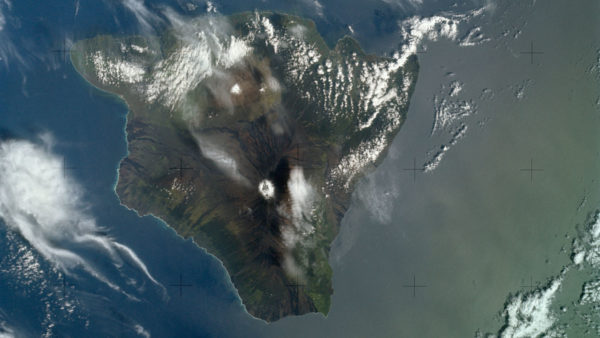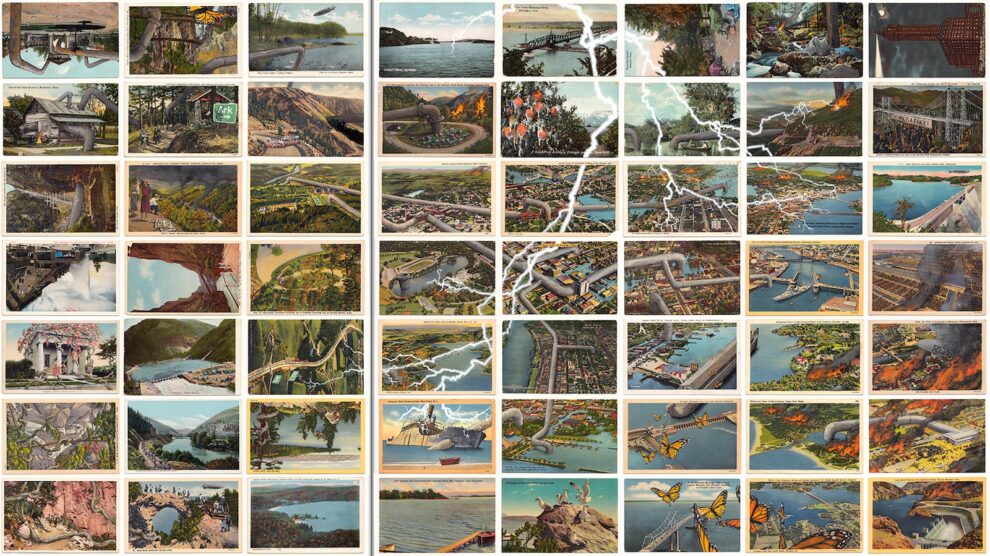Indigenous Knowledge, Western Science, and the US Colonial Project
By Ragina Johnson and Brian Ward
Volume 23, number 1, Science Under Occupation

“Indigenous Peoples were always scientists”
“We are not anti-science. It’s not culture versus science. We are against the building of anything eighteen stories over our watershed, water aquifers, on our sacred mountain. It could have been anything; it just happens to be a telescope.”
These were the powerful words of Pua Case in 2019.1 Case is an indigenous land activist, organizer, and protector, who has been fighting the approval and construction of the Thirty Meter Telescope (TMT) atop Mauna Kea, the tallest mountain on Earth and a place sacred to Native Hawaiians. Mauna Kea has already been desecrated in the name of science, capitalism and colonialism; currently, there are thirteen telescopes on her surface.
The TMT was “approved” in 2019 without the consent of Native peoples in Hawaiʻi. Their resistance escalated when the US settler state, in collaboration with four other countries, tried to push through the billion dollar project.2 Native elders and Indigenous Hawaiʻians have courageously organized an encampment and have so far successfully blocked construction, refusing workers and equipment access to their sacred site.
Dina Gilio-Whitaker, a citizen of the Colville Confederated Tribes and author of As Long as Grass Grows: The Indigenous Fight for Environmental Justice, from Colonization to Standing Rock, explained the difference between Western science and Native science:3
“Western science is the pursuit of knowledge, just as Native science is the pursuit of knowledge…. But with western science it’s very reductionistic, very concerned with mathematical equations, and experimentation and replicability and quantification. Native science is not so concerned with those particularities. It’s more concerned with what you know about the world based on experience within it over long periods of time.”4
In a positive development, many scholars have started to take Indigenous knowledge and Native science seriously. In 2000, Greg Cajete, who is Tewa from the Santa Clara Pueblo, published his book, Native Science: Natural Laws of Interdependence, bringing attention to Indigenous knowledge in the Academy.5 Indigenous people build relationships with their surroundings over thousands of years and use that knowledge to live sustainably with the non-human world. Scholars and Indigenous scientists have referred to this as Traditional Ecological Knowledge or TEK.6
As the state of the climate crisis deepens—catastrophic flooding, fires, droughts, species extinction, and millions forced into migration—our attempts to fix these crises will fail unless we learn and respect the knowledge and solutions provided by Indigenous people.
Corporations and states are attempting to steal Indigenous lands and resources by force for capitalist expansion through mining, deforestation, fossil fuel extraction, and dam building projects.7 Our movements should prioritize returning land to Native people and listening to their solutions. The Rights and Resources Initiative reports that, globally, Indigenous peoples and local communities hold communally up to 65 percent of the world’s land, which contains 80 percent of the world’s biodiversity.8
Unprecedented numbers of Indigenous activists have been dying in the Amazon while protecting their lands and the “lungs of the planet,” as governments and corporations vie for power and profits. Most recently, we have seen a right-wing coup in Bolivia, a majority Indigenous country, in which their first Indigenous president, Evo Morales, was overthrown. Morales came to power in 2006 through powerful social movements that demanded an Indigenous-centered view to give rights to Pachamama (the Andean Earth Mother).
At the Indigeneity and Climate Change conference at UC Santa Cruz in May 2019, Chairman Valentin Lopez spoke about how climate change is affecting the Amuh Mutsun, an Indigenous Nation within the state of California who are of the lands Popelouchom. Lopez detailed how they are engaged in a process to restore and relearn their language, culture, and knowledge.9 Chairman Valentin contrasted sustainable Indigenous land practices, which look out for the next seven generations, to “science [that] only lasts until the check is cashed.”10
Today, there is both a growing ecological justice movement and a movement of scientists who see these connections between history, place, and solutions—connections that flow from the idea that we are not separate from nature. Indigenous scientists are asserting their rightful place as scientific leaders.
Ecologist Corey Welch, Northern Cheyenne, writes, “Indigenous peoples were always scientists. Their lives depended on it. They knew what plants to eat, how to harvest game, and other practices that continue on today.”11
Settler-Colonialism and the Process of Land Seizure
“In the settler mind, land was property, real estate, capital, or natural resources. But to our people, it was everything: identity, the connection to our annectors, the home of our nonhuman kinfolk, our pharmacy, our library, the source of all that sustained us.”
– Robin Wall Kimmerer, Braiding Sweetgrass12
Land has always been at the center of the US colonial project. As a country, the United States projects myths around the taming of the wilderness, implying that Turtle Island, or North America as the colonizers have named it, was empty of people when the settlers arrived. The reality is that there were millions of people living in North America. The majority were farmers, who lived sustainably with their non-human relatives. In his book Red Skin, White Masks: Rejecting the Colonial Politics of Recognition, Glen Coulthard, a citizen of the Yellowknives Dene, describes Marx’s theory of primitive accumulation as the process where capital displaces the Indigenous population and privatizes the land to make it a commodity. This is what Coulthard calls a “violent transformation of noncapitalist forms of life into capitalist ones.”13
That totalizing power of capital in the North American context required settlers and settler-colonialism to overturn Indigenous modes of production and relationship to the land and supplant these with capitalist markets. Previously, most Indigenous Nations on Turtle Island did not have “private property,” and land was held in common. Along with private property, colonialism brought individualism to drive the commodification of land. In contrast, Indigenous Nations relied on interdependence and what Winona LaDuke calls co-evolution with their environment and surroundings. From the Indigenous perspective, colonialism transformed abundance to scarcity.
Capitalism needs to commodify land in order to exploit it for profit. In order to do this, relationships to the non-human world had to be transformed; the only relationships that were acceptable were humans with commodities, in both economic and political systems.
Indigenous Knowledge: Past and Present
The Menominee Nation of Wisconsin has always viewed their dense forest along the Wolf River in Northern Wisconsin as sacred. As soon as you enter the forest, you feel its power, a stark contrast with the emotional pain of going through a clearcut forest. Over generations, the Menominee have managed their relationship with the forest in a sustainable way. In fact, the outline of their reservation can be seen from space, against the surrounding land owners’ monocrop farms.
Doris Karambu Onesmus explains the foundations of this management, saying, “The decision on which trees to cut and which to leave in any one stand is based on a rigorous scientifically based understanding of the forest.” For Menominee Tribal Enterprises (MTE), run by the Menominee, the sustainability of the forest is given priority above all else.14
The Menominee, like the Amah Mutsun, want a future we should all support, in which all people can drink from clean waters and breathe clean air, and in which Indigenous people can hunt and harvest based on their traditions, conduct their sacred ceremonies, protect their sacred sites, and live connected to the land.
The urgency of learning these practices from Indigenous Nations is clear. Australia, California, Portugal, and the Arctic have all faced record-breaking fires over the last couple of years; these are likely to continue. Such ecological breakdowns are due to hundreds of years of colonialism and capitalism, severing Indigenous peoples from their lands and practices. As Dina Gilio-Whitter has rightfully pointed out, “The problem with the narrative that we’re hearing now about how these radical fires are due to climate change, is that it’s really not due to climate change, not entirely. It’s due to a century of mismanaging forests so this leads to the conditions that climate change exacerbates.” This mismanagement interrupted Indigenous sustainable agricultural practices. Gilio-Whitter continues, “Everywhere in California was tended by Native Peoples who were considered wild land horticulturalists…it’s about managing landscapes to maximize food production, production of cultural materials like baskets and clothing, encouraging the healthy production of these plant populations by different means and techniques like pruning…and burning.”15
The Way Forward
The connections between western science and Indigenous knowledge are becoming stronger every day, thanks to Indigenous scientists and leaders. In a statement of support for the March for Science, a group of Indigenous scientists wrote, “Indigenous science provides a wealth of knowledge and a powerful alternative paradigm by which we understand the natural world and our relation to it. Embedded in cultural frameworks of respect, reciprocity, responsibility, and reverence for the earth, Indigenous science lies within a worldview where knowledge is coupled to responsibility and human activity is aligned with ecological principles and natural law, rather than against them.”16 The survival of our planet depends on embracing these connections.
The struggle to halt the climate crisis should center Indigenous land rights and knowledge. Science organizations and associations need to listen to and collaborate with Indigenous people, who are already doing the work and leading the way. As Chairman Valentin said, “Every inch of land was once Indigenous land.”17
Another essential aspect of ending capitalism and settler-colonialism is returning land to Indigenous people. Since the Red Power movement of the 1970s, the US government has been forced to give back some Indigenous land: Taos Blue Lake was returned to the Taos Pueblo in 1970, while two years later Mount Pahto (Adams) was returned to the Yakama Nation.18 The Wiyot Nation in California had been struggling since the 1860s—a century and a half—to have their lands returned; they have only recently won stewardship over their island. The Wiyot are rehabilitating the ecology of the island, while restoring their ceremonies, practice, and culture.19
Many Indigenous communities have been on the front lines of fighting the extractive industry for centuries, as shown by the resistance at Standing Rock against the Dakota Access Pipeline, the Keystone XL pipeline, the Trans Mountain pipeline, and the many other pipelines criss-crossing Indigenous land throughout North America.20 Indigenous organizations such as the White Earth Land Recovery Project, as well as leaders like Winona LaDuke, are providing a way forward by working to recover their original land base, so that they can produce renewable energy while restoring traditional practices of sound land stewardship.
We need Indigenous knowledge at the center of our vision for a sustainable and just future. Systems like settler-colonialism and capitalism live off the death of the world around us while commodifying the things we love and hold dear. These are systems that intentionally separate our work and obscure any connections between them. We need to fight for a decolonized Turtle Island that puts people and the planet before profits.
About the Authors
Ragina Johnson is a Native activist, socialist, mom, and graphic designer living in Ramaytush Territory, the lands of the Ohlone and Muwekma people in the Bay Area. Her relatives are from the Otoe-Missouria Tribe and Ojibway from the Turtle Mountain Band of Chippewa Indians. Ragina has been active with Science for the People in the Bay Area and is currently involved in struggles for Native liberation, immigrant, and environmental justice.
Brian is an educator, socialist and activist who lives in Madison, Wisconsin (occupied Ho-Chunk Land), and has lived and worked on Pine Ridge Indian Reservation, home of the Oglala Lakota Nation. He contributed to the book 101 Changemakers: Rebels and Radicals Who Changed U.S. History and his writing has appeared in The Nation, Truthout, New Politics, Socialist Worker, International Socialist Review and more.
References
- “‘We Are Not Anti-Science’: Why Indigenous Protectors Oppose the Thirty Meter Telescope at Mauna Kea,” Democracy Now!, July 22, 2019, https://www.democracynow.org/2019/7/22/why_indigenous_protectors_oppose_the_thirty.
- See tmt.org.
- Dina Gilio-Whitaker, As Long as Grass Grows: The Indigenous Fight for Environmental Justice, from Colonization to Standing Rock (Boston: Beacon Press, 2019).
- Interview with Dina Gilio-Whitaker conducted by Ragina Johnson and Brian Ward.
- Michael Wassegijig Price, “Native Science: Natural Laws of Interdependence,” Tribal College: Journal of American Indian Higher Education, https://tribalcollegejournal.org/author/mprice/.
- George Nicholas, “It’s taken thousands of years, but Western science is finally catching up to Traditional Knowledge,” The Conversation, February 2018, http://theconversation.com/its-taken-thousands-of-years-but-western-science-is-finally-catching-up-to-traditional-knowledge-90291.
- VTD Editor, “Indigenous activists fight expansion of Canadian hydropower,” December 2019, VTDigger, https://vtdigger.org/2019/12/08/indigenous-activists-fight-expansion-of-canadian-hydropower/; Nina Negron, “Fracking leaves heavy footprint in Argentina’s Patagonia,” Phys.org, December, 2019, https://phys.org/news/2019-12-fracking-heavy-footprint-argentina-patagonia.html; Andrés Bermúdez Liévano, “Ecuador Mining Conflict Evolves Into a Battle for Indigenous Identity,” Pulitzer Center, July 2019, https://pulitzercenter.org/reporting/ecuador-mining-conflict-evolves-battle-indigenous-identity.
- See rightsandresources.org.
- The Feminist Studies Department organized a Feminist Science Studies Conference on Indigeneity and Climate Justice at UC Santa Cruz on May 30-31, 2019, https://feministstudies.ucsc.edu/news-events/department-news/science-conference/index.html.
- Indigeneity and Climate Justice Conference attended by Ragina Johnson.
- Terri Hansen, “How Indigenous Knowledge Is Transforming the March for Science”, YES!, April 13, 2018.
- Robin Wall Kimmerer, Braiding Sweetgrass (Minneapolis: Milkweed Editions, 2013), 17.
- Glen Coulthard, Red Skin, White Masks: Rejecting the Colonial Politics of Recognition (Minneapolis: University of Minnesota Press, 2014), 7.
- Doris Karambu Onesmus, “Sustainable Management Of Forest By Menominee Tribe From Past To Present”, University of Wisconsin-Stevens Point, Student Journal: Native American Forestry, 2008, https://www.uwsp.edu/forestry/StuJournals/Documents/NA/donesmus.pdf.
- Interview with Dina Gilio-Whitaker conducted by Ragina Johnson and Brian Ward.
- Indigenous Science Statement for the March for Science, April 18, 2017; see esf.edu/indigenous-science-letter.
- Andy Miller, Umunhum (Plus M Productions, 2018), video.
- “Taos Blue Lake” Sacred Land Film Project, last updated September 29, 2010, https://sacredland.org/taos-blue-lake-united-states/.
- Associated Press, “California city returns island taken from native tribe in 1860 massacre,” The Guardian, October 21, 2019, https://www.theguardian.com/us-news/2019/oct/21/california-city-returns-island-taken-from-native-tribe-in-1860-massacre.
- While some Indigenous Nations like the Navajo, Crow and Mandan, and Hidatsa and Arikara have asserted their economic independence and sovereignty by choosing the path of energy extraction. Dina Gilio-Whitaker, As Long as the Grass Grows.





